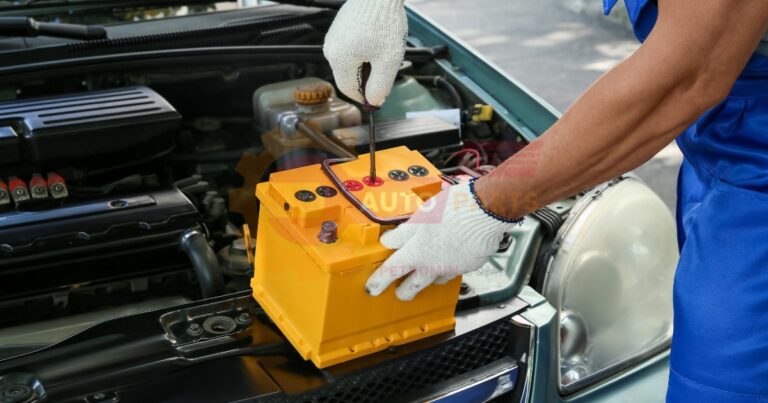Car Battery Basics
What is a car battery?
A car battery is a crucial component of a vehicle’s electrical system, providing the necessary power to start the engine and run electrical accessories. It stores chemical energy and converts it into electrical energy to power the vehicle. Without a functioning car battery, a car would not be able to start or operate its electrical systems.
Components of a car battery
Car batteries consist of several key components that work together to produce and store electricity. These include the positive and negative plates, separators, electrolyte solution, and the battery case. The plates are typically made of lead and lead dioxide, while the electrolyte is a mixture of sulfuric acid and water. The separators prevent the plates from touching and short-circuiting, and the case holds everything together.
- Positive and negative plates
- Separators
- Electrolyte solution
- Battery case
Types of car batteries
There are various types of car batteries, each designed for specific needs and vehicle types. The most common types include lead-acid batteries, absorbed glass mat (AGM) batteries, and lithium-ion batteries. Lead-acid batteries are the most traditional and widely used, while AGM batteries offer better performance and durability. Lithium-ion batteries are more common in electric and hybrid vehicles due to their lightweight and high energy density.
- Lead-acid batteries
- Absorbed glass mat (AGM) batteries
- Lithium-ion batteries
Car Battery Function and Operation
How does a car battery produce electricity?
A car battery produces electricity through a chemical reaction between the lead plates and the sulfuric acid in the electrolyte. This reaction generates electrons, which flow through the battery terminals and provide power to the vehicle’s electrical system. The process is reversible, allowing the battery to be recharged and used repeatedly.
The role of electrolytes in car batteries
Electrolytes play a vital role in the functioning of car batteries by facilitating the chemical reaction that generates electricity. The sulfuric acid in the electrolyte reacts with the lead plates, creating a flow of electrons. This process is essential for the battery’s ability to store and deliver power.
Charging and discharging cycles
Car batteries undergo charging and discharging cycles as they provide power to the vehicle and are recharged by the alternator. During discharge, the battery supplies electricity to the car’s systems. When the engine is running, the alternator recharges the battery, restoring its energy levels. Proper management of these cycles is crucial for maintaining battery health and longevity.
- Discharge: supplies electricity
- Charge: recharged by alternator
- Cycle management is crucial
Car Battery Maintenance and Testing
Signs of a failing car battery
Recognizing the signs of a failing car battery can prevent unexpected breakdowns. Common indicators include slow engine cranking, dim headlights, and frequent need for jump-starts. If you notice any of these symptoms, it’s essential to test your battery and consider a replacement if necessary.
How to test a car battery with a multimeter
Testing a car battery with a multimeter is a straightforward process that can help determine its health. First, set the multimeter to measure voltage. Connect the red probe to the positive terminal and the black probe to the negative terminal. A healthy battery should read around 12.6 volts. If the reading is significantly lower, it may be time for a replacement.
Proper car battery maintenance tips
Proper maintenance can extend the life of your car battery and ensure reliable performance. Regularly check the battery terminals for corrosion and clean them if necessary. Ensure the battery is securely mounted and inspect it for any signs of damage. Additionally, avoid leaving electrical accessories on when the engine is off to prevent unnecessary discharge.
- Check for terminal corrosion
- Securely mount the battery
- Avoid unnecessary discharge
Car Battery Lifespan and Replacement
Average lifespan of a car battery
The average lifespan of a car battery is typically between three to five years. However, this can vary based on factors such as usage, climate, and maintenance. Regular testing and proper care can help maximize the battery’s lifespan.
Factors affecting battery life
Several factors can impact the lifespan of a car battery. Extreme temperatures, frequent short trips, and lack of maintenance can all contribute to a shorter battery life. It’s important to be aware of these factors and take steps to mitigate their effects.
- Extreme temperatures
- Frequent short trips
- Lack of maintenance
When to replace your car battery
Knowing when to replace your car battery is crucial for avoiding unexpected failures. If your battery is more than three years old and shows signs of weakness, it’s wise to have it tested. If it fails the test or requires frequent jump-starts, it’s time for a replacement.
Innovations in Car Battery Technology
Advancements in lead-acid batteries
Recent advancements in lead-acid battery technology have improved their efficiency and lifespan. Enhanced designs and materials have led to better performance and reduced maintenance requirements. These improvements make lead-acid batteries a reliable choice for many vehicles.
Alternative battery technologies for vehicles
Alternative battery technologies, such as lithium-ion and solid-state batteries, are gaining popularity in the automotive industry. These batteries offer higher energy density, faster charging times, and longer lifespans compared to traditional lead-acid batteries. They are particularly beneficial for electric and hybrid vehicles.
Future of car batteries
The future of car batteries is promising, with ongoing research and development focused on improving performance and sustainability. Innovations such as solid-state batteries and advanced recycling methods are expected to revolutionize the industry, making car batteries more efficient and environmentally friendly.
Car Battery Safety and Environmental Concerns
Proper handling and disposal of car batteries
Proper handling and disposal of car batteries are essential for safety and environmental protection. Always wear protective gear when handling batteries and avoid contact with the electrolyte. Dispose of old batteries at designated recycling centers to prevent environmental harm.
Environmental impact of car batteries
Car batteries can have a significant environmental impact if not disposed of properly. The lead and acid in batteries can contaminate soil and water, posing risks to wildlife and human health. Recycling helps mitigate these effects by recovering valuable materials.
Recycling car batteries
Recycling car batteries is crucial for reducing environmental impact and conserving resources. According to the U.S. Department of Energy, about 99% of lead-acid batteries are recycled, making them one of the most recycled consumer products. This process recovers lead and other materials for reuse. Battery testing techniques Check how long batteries last and how strong they are by using special tools and methods Vehicle power classifications
Car battery replacement timing Most car batteries last 3 to 5 years before needing replacement but extreme temperatures and frequent short trips can shorten their lifespan Car voltage levels Most cars use a 12-volt electrical system to power lights and other components while some electric vehicles have higher voltage systems for their motors and batteries
Jumpstart dead battery is a quick way to get your car running again when the battery is out of power You can use special cables to connect your car’s dead battery to another car’s working battery to bring it back to life Electrical system weakens when power lines get old or damaged This can cause lights to flicker and appliances to work poorly
Battery selection guide Choose the right battery for your device by looking at size voltage and how long it lasts Automotive energy solutions help cars and trucks run using different power sources like electricity batteries and hydrogen fuel cells instead of just gasoline These new ways of powering vehicles can make them cleaner and better for the environment
Choosing the Right Car Battery
Factors to consider when selecting a car battery
When selecting a car battery, consider factors such as size, capacity, and brand reputation. Ensure the battery fits your vehicle’s specifications and meets your performance needs. It’s also important to choose a reputable brand for reliability and warranty support.
AM Autoparts battery selection guide
AM Autoparts offers a comprehensive battery selection guide to help you choose the right battery for your vehicle. Their guide provides detailed information on battery types, sizes, and performance ratings. This resource can simplify the selection process and ensure you make an informed decision.
Installation tips for new car batteries
Proper installation of a new car battery is essential for optimal performance. Begin by disconnecting the negative terminal, followed by the positive terminal. Remove the old battery and place the new one in the tray, securing it with the hold-down clamp. Reconnect the terminals, starting with the positive terminal, and ensure all connections are tight.
- Disconnect negative terminal first
- Secure new battery with hold-down clamp
- Reconnect terminals, starting with positive
FAQ’s
How long does a car battery last?
A car battery typically lasts between three to five years, depending on various factors such as usage and climate. Regular maintenance and testing can help extend its lifespan. It’s important to monitor your battery’s health to avoid unexpected failures.
Can a car battery die suddenly?
Yes, a car battery can die suddenly, especially if it’s old or has been poorly maintained. Factors like extreme temperatures and leaving lights on can also cause sudden failure. Regular testing and maintenance can help prevent this issue.
How do I know if my car needs a new battery?
You may need a new car battery if you experience slow engine cranking, dim headlights, or frequent jump-starts. Testing the battery with a multimeter can confirm its health. If the battery fails the test, it’s time for a replacement.






